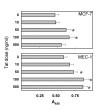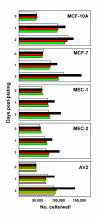Proliferative activity of extracellular HIV-1 Tat protein in human epithelial cells: expression profile of pathogenetically relevant genes
- PMID: 15857508
- PMCID: PMC1090582
- DOI: 10.1186/1471-2180-5-20
Proliferative activity of extracellular HIV-1 Tat protein in human epithelial cells: expression profile of pathogenetically relevant genes
Abstract
Background: Tat is being tested as a component of HIV vaccines. Tat activity has been mainly investigated on cells of lymphoid/hematopoietic lineages. HIV-1, however, is known to infect many different cells of both solid organs and mucosal surfaces. The activity of two-exon (aa 1-101) and synthetic (aa 1-86) Tat was studied on mammary and amniotic epithelial cells cultured under low serum conditions.
Results: small concentrations of Tat (100 ng/ml) stimulated cell proliferation. Tat antibodies neutralized the mitogenic Tat activity. Changes of gene expression in Tat-treated cells were evaluated by RT-PCR and gene-array methods. Within 4 hours of treatment, exposure to Tat is followed by up-regulation of some cell cycle-associated genes (transcription factors, cyclin/cdk complexes, genes of apoptotic pathways) and of genes relevant to HIV pathogenesis [chemokine receptors (CXCR4, CCR3), chemotactic cytokines (SDF-1, RANTES, SCYC1, SCYE1), IL6 family cytokines, inflammatory cytokines, factors of the TGF-beta family (TGFb, BMP-1, BMP-2)]. Up-regulation of anti-inflammatory cytokines (IL-10, IL-19, IL-20), a hallmark of other persistent viral infections, was a remarkable feature of Tat-treated epithelial cell lines.
Conclusion: extracellular Tat is mitogenic for mammary and amniotic epithelial cells and stimulates the expression of genes of pathogenetic interest in HIV infection. These effects may favor virus replication and may facilitate the mother-to-child transmission of virus.
Figures




Similar articles
-
HIV-1 tat protein and cell proliferation and survival: a brief review.New Microbiol. 2005 Apr;28(2):95-109. New Microbiol. 2005. PMID: 16035254 Review.
-
Estrogen-mediated protection against HIV Tat protein-induced inflammatory pathways in human vascular endothelial cells.Cardiovasc Res. 2004 Jul 1;63(1):139-48. doi: 10.1016/j.cardiores.2004.03.006. Cardiovasc Res. 2004. PMID: 15194470
-
Regulatory functions of Cdk9 and of cyclin T1 in HIV tat transactivation pathway gene expression.J Cell Biochem. 1999 Dec 1;75(3):357-68. J Cell Biochem. 1999. PMID: 10536359 Review.
-
HIV-1 Tat depresses DNA-PK(CS) expression and DNA repair, and sensitizes cells to ionizing radiation.Int J Radiat Oncol Biol Phys. 2006 Jul 1;65(3):842-50. doi: 10.1016/j.ijrobp.2006.02.040. Int J Radiat Oncol Biol Phys. 2006. PMID: 16751065
-
Extracellular HIV-1 tat protein up-regulates the expression of surface CXC-chemokine receptor 4 in resting CD4+ T cells.J Immunol. 1999 Feb 15;162(4):2427-31. J Immunol. 1999. PMID: 9973525
Cited by
-
Fluctuations in Tat copy number when it counts the most: a possible mechanism to battle the HIV latency.Theor Biol Med Model. 2013 Mar 5;10:16. doi: 10.1186/1742-4682-10-16. Theor Biol Med Model. 2013. PMID: 23497153 Free PMC article.
-
Altered expression of the tetraspanin CD81 on B and T lymphocytes during HIV-1 infection.Clin Exp Immunol. 2007 Jan;147(1):53-9. doi: 10.1111/j.1365-2249.2006.03250.x. Clin Exp Immunol. 2007. PMID: 17177963 Free PMC article.
-
The functionality of African-specific variants in the TGFB1 regulatory region and their potential role in HIVAN.Clin Exp Nephrol. 2018 Aug;22(4):764-772. doi: 10.1007/s10157-017-1516-4. Epub 2017 Dec 4. Clin Exp Nephrol. 2018. PMID: 29204904
-
HIV-1 Tat-induced disruption of epithelial junctions and epithelial-mesenchymal transition of oral and genital epithelial cells lead to increased invasiveness of neoplastic cells and the spread of herpes simplex virus and cytomegalovirus.Front Immunol. 2025 Feb 13;16:1541532. doi: 10.3389/fimmu.2025.1541532. eCollection 2025. Front Immunol. 2025. PMID: 40018040 Free PMC article. Review.
-
Interleukin-10 (IL-10) pathway: genetic variants and outcomes of HIV-1 infection in African American adolescents.PLoS One. 2010 Oct 14;5(10):e13384. doi: 10.1371/journal.pone.0013384. PLoS One. 2010. PMID: 20976276 Free PMC article.
References
-
- Viscidi RP, Mayur K, Lederman HM, Frankel AD. Inhibition of antigen-induced lymphocyte proliferation by Tat protein from HIV-1. Science. 1989;246:1606–1608. - PubMed
-
- Weissman JD, Brown JA, Howcroft TK, Hwang J, Chawla A, Roche PA, Schiltz L, Nakatani Y, Singer DS. HIV-1 Tat binds TAFII250 and represses TAFII250-dependent transcription of major histocompatibility class I genes. Proc Natl Acad Sci USA. 1998;95:11601–11606. doi: 10.1073/pnas.95.20.11601. - DOI - PMC - PubMed
-
- Tosi G, De Lerma Barbaro A, D'Agostino A, Valle MT, Megiovanni AM, Manca F, Caputo A, Barbanti-Brodano G, Accolla RS. HIV-1 Tat mutants in the cysteine-rich region down-regulate HLA class II expression in T lymphocytic and macrophage cell lines. Eur J Immunol. 2000;30:19–28. doi: 10.1002/1521-4141(200001)30:1<19::AID-IMMU19>3.3.CO;2-0. - DOI - PubMed
-
- Caldwell RL, Egan BS, Shepherd VL. HIV-1 Tat represses transcription from the mannose receptor promoter. J Immunol. 2000;165:7035–7041. - PubMed
Publication types
MeSH terms
Substances
LinkOut - more resources
Full Text Sources
Other Literature Sources
Medical
Miscellaneous

